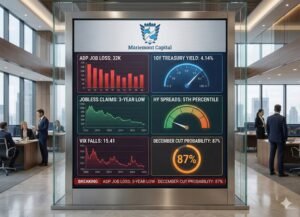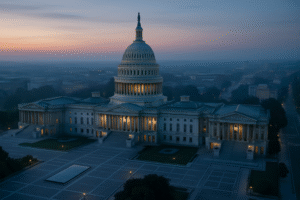Duration & Credit Pulse
Executive Summary
Bottom Line: The week of November 9-16 marked an important shift as the 43-day government shutdown ended, yet Fed December rate cut 2025 probability declined from 95% to approximately 40-50% amid significant FOMC divisions. Treasury yields continued rising with the curve advancing 5 basis points across all maturities despite October's rate reduction, while credit markets maintained tight spreads—investment grade at 78 basis points (34th percentile) and high yield at 275 basis points (22nd percentile)—reflecting technical support from record fund inflows that offset valuation concerns.
Duration Dashboard
| Maturity | November 9, 2025 | November 16, 2025 | Weekly Δ | 5-Year Percentile |
|---|---|---|---|---|
| 2‑Year | 3.56% | 3.61% | +5 bp | 41st %ile (middle range) |
| 5‑Year | 3.69% | 3.73% | +5 bp | 50th %ile (middle range) |
| 10‑Year | 4.10% | 4.15% | +5 bp | 66th %ile (middle range) |
| 30‑Year | 4.70% | 4.75% | +5 bp | 87th %ile (elevated) |
Parallel Shift Higher Despite Fed Cuts
Curve Analysis: Treasury markets posted near-uniform increases of approximately 5 basis points across all maturities (ranging 4.5-5.1 bp), a pattern that typically indicates broad repricing of term premium rather than shifting Fed policy expectations. The 2s30s spread held steady at 114 basis points, indicating markets priced dovish Fed intentions alongside persistent term premium requirements. The 30-year yield reaching the 87th percentile of its 5-year range reflected investor requirements for compensation against fiscal uncertainty and inflation risks that Fed rate cuts alone cannot address.
The uniformity of this week's Treasury yield increases—ranging from 4.5 to 5.1 basis points across the 2-year, 5-year, 10-year, and 30-year maturities—suggested broad repricing of term premium rather than changing Fed policy expectations, as markets incorporated the reality that October data would never be collected during the shutdown. The 10-year benchmark settling at 4.15% marked its 66th percentile positioning, while the 30-year's advance to 4.75% pushed it into elevated territory at the 87th percentile—a spread between percentile rankings that typically signals flattening bias but was absent this week due to the synchronized move.
Credit Pulse
| Metric | November 9, 2025 | November 16, 2025 | Weekly Δ | 5-Year Percentile |
|---|---|---|---|---|
| IG OAS | 79 bp | 78 bp | -1 bp | 34th %ile (middle range) |
| HY OAS | 280 bp | 275 bp | -5 bp | 22nd %ile (low) |
| VIX Index | 19.08 | 19.83 | +0.75 | 61st %ile (middle range) |
Credit spreads tightened modestly as investment grade narrowed 1 basis point to 78bp and high yield compressed 5bp to 275bp, maintaining positions near the tightest levels in 15 years despite rising Treasury yields and Fed policy uncertainty. This performance reflected technical support—particularly the record $15.18 billion of bond fund inflows for the week ended November 5—that offset fundamental concerns about valuations at historically tight levels. The VIX's modest rise to 19.83 (61st percentile) indicated contained equity market anxiety, with credit investors viewing the government shutdown resolution and gradual economic data resumption as removing tail risks rather than creating new concerns.
US Macroeconomic Assessment – Navigating Without Data
The November 12 resolution of the longest government shutdown in US history provided relief but left an unprecedented void in economic intelligence that fundamentally altered how markets and policymakers operated during the week of November 9-16. Federal statistical agencies remained shuttered through the November 14 release date for September employment data, creating a 43-day blackout during which no major economic indicators were collected or published. The permanent gap in October 2025 data meant the Fed would make critical December rate decisions without baseline readings on employment, inflation, or economic activity from a key month.
Private data filled the statistical vacuum: With official government data absent, markets relied heavily on alternative indicators to assess economic conditions. ADP reported estimated private payrolls of just 6,500 per month for September-October combined based on state-level data, suggesting significant labor market softening. Initial jobless claims for the week ending November 8 were estimated at 227,543, virtually unchanged from 228,899 the prior week, while continuing claims hovered near 1.94 million. The most recent official inflation reading remained September CPI released October 24, showing headline at 3.0% year-over-year and core at 3.0%—both below consensus—but economists acknowledged that October data would never be collected due to the shutdown's disruption of in-person store price surveys.
Business surveys revealed mounting strain: Corporate sentiment indicators painted a concerning picture during the data blackout. The University of Michigan consumer sentiment index fell sharply in October to near-record lows, reflecting both shutdown anxieties and deteriorating economic perceptions. Challenger, Gray & Christmas reported roughly 1 million job cut announcements in 2025 through October, up 65% from 2024's pace, with particular concentration in technology and retail sectors. Regional Fed surveys—which continued through the shutdown—showed mixed signals, with manufacturing indices weakening while services activity held relatively firm.
Housing affordability reached historic extremes: Mortgage rates remaining above 7% despite Fed rate cuts created unprecedented affordability challenges, with the income required to afford a median-priced home up 50% since 2020 while median household income rose only 26%. Housing starts data remained delayed by the shutdown, but building permit applications tracked by private sources showed builders retrenching in response to the combination of high rates, elevated construction costs from steel and lumber tariffs, and weakening buyer demand. The residential investment component of GDP faced headwinds that would persist regardless of Fed policy adjustments.
Federal Reserve Policy Outlook – Fed December Rate Cut 2025 in Question
The Fed December rate cut 2025 outlook shifted notably during the week of November 9-16, with market-implied probability declining from 95% at the start of November to approximately 40-50% by week's end as Federal Reserve officials delivered divergent messages about appropriate policy. The significant division within the FOMC—featuring two officials disclosing they opposed October's rate reduction and one Governor explicitly calling for a December cut—ended the consensus that Chair Powell had maintained for years and left markets uncertain about the Committee's next move.
The hawkish hold camp gained momentum mid-week: Atlanta Fed President Raphael Bostic delivered the clearest articulation of the pause case on November 12 at the Atlanta Economics Club, arguing that "the clearer and urgent risk is still price stability" given inflation had exceeded 2% for nearly five years. He characterized policy as "marginally restrictive" and stated he would favor "keeping the funds rate steady until we see clear evidence that inflation is again moving meaningfully toward its 2% target." His Atlanta Fed's CFO Survey revealed companies planning to raise prices well into 2026, with only 40% of cost growth attributed to tariffs—evidence that inflationary pressures extended beyond trade policy. Kansas City Fed President Jeffrey Schmid reinforced this stance on November 14, revealing he dissented at the October 28-29 FOMC meeting, preferring to hold rates steady. He emphasized that "inflation remains too high, the economy shows continued momentum, and the labor market—though cooling—remains largely in balance."
Governor Waller presented a contrasting view: Fed Governor Christopher Waller offered a different perspective on November 17 in London, explicitly supporting a 25 basis point Fed December rate cut 2025 at the upcoming FOMC meeting. His speech titled "The Case for Continuing Rate Cuts" argued that "the labor market is still weak and near stall speed," citing the ADP estimate of only 6,500 jobs created per month in September-October. Waller expressed particular concern about how "restrictive monetary policy is weighing on the economy, especially about how it is affecting lower- and middle-income consumers," pointing to housing affordability at historic lows and continuing unemployment claims rising above 2023-2024 levels. He characterized a December cut as "risk management" providing "additional insurance against an acceleration in the weakening of the labor market."
Market pricing reflected the uncertainty: Fed funds futures showed December rate cut probability declining from 95% in early November to 67% by November 12, then 63% by November 14, ultimately settling near 40-50% by November 17. The significant repricing represented a notable shift in Fed expectations, transforming from "nearly certain" to approximately even odds in just two weeks. The 6-month Treasury bill settling at 3.80%—squarely within the Fed's 3.75%-4.00% target range—indicated markets expected the Committee to hold in December rather than deliver the additional easing that had been fully priced just weeks earlier.
Treasury Market Dynamics
Treasury yields November 2025 continued their counterintuitive climb despite the Fed having cut rates in October, with the week of November 9-16 seeing uniform 5 basis point increases across all maturities. The 10-year benchmark rose from 4.10% to 4.15%, the 2-year climbed from 3.56% to 3.61%, and the 30-year advanced from 4.70% to 4.75%. This parallel shift higher reflected broad repricing of term premium—the extra yield investors demand for holding longer-dated securities—rather than changing expectations for Fed policy rates. Markets incorporated the reality that the shutdown's data gap would impair policymaking and that fiscal uncertainty would persist regardless of near-term monetary adjustments.
Three Treasury auctions during the week demonstrated solid demand despite the uncertain environment. The 3-year note auction on November 10 showed robust participation with a bid-to-cover ratio of 2.85—the highest in 12 months—and a high yield of 3.579%. The 10-year note auction on November 12 generated solid interest with bid-to-cover of 2.43 and high yield of 4.074%, with indirect bidders (foreign central banks and investors) taking 86.9% of their allocation. The 30-year bond auction on November 13 saw somewhat softer demand with bid-to-cover of 2.29 and high yield of 4.694%, but indirect bidders remained dominant at 90.5% of what they bid for. Primary dealers were left with minimal amounts, indicating strong end-user demand that didn't require dealer facilitation.
Credit Market Conditions
Corporate credit markets maintained tight spreads during the week despite Treasury yield increases and Fed policy uncertainty, with investment grade tightening 1 basis point to 78bp and high yield compressing 5bp to 275bp. These levels represented the tightest in approximately 15 years, reflecting technical support from record fund inflows, solid corporate fundamentals, and foreign demand seeking yield. The $15.18 billion of combined bond fund and ETF inflows for the week ended November 5 (most recent data available) provided substantial buying power that offset concerns about valuations at historically tight levels.
Year-to-date investment grade issuance through November 12 reached $1.499 trillion, surpassing all of 2024's $1.496 trillion total and marking the second-highest year on record after 2020's $1.75 trillion. The strong issuance reflected refinancing activity, M&A financing (13% of 2025 volume), and AI infrastructure capital expenditures from technology and utility sectors. Sector performance showed defensive bias, with healthcare and pharmaceuticals trading around 100 basis points over Treasuries, while utilities led issuance growth with volumes up 18% versus 2024 driven by data center power demand. Rating agency actions remained constructive, with upgrades exceeding downgrades approximately 3:1 for US investment-grade bonds, though high-yield default rates stood at 4.3% as of May 2025.
Policy and Market Implications
The week's events highlighted several considerations for fixed income investors navigating the intersection of missing economic data, Fed policy uncertainty, and tight credit valuations. Duration strategies faced continued challenges as the post-rate-cut yield rise extended, running counter to expectations of curve flattening and bull steepening. Credit over governments remained the preferred stance, with stable-to-tight spreads compensating for Treasury volatility and all-in yields near 4.9% for investment grade offering solid total return potential if spreads held.
The December 9-10 FOMC meeting represents an important decision point, with approximately even odds of cutting versus holding reflecting genuine Committee division rather than market confusion. The permanent gap in October economic data will impair policymaking well into 2026, as Fed officials lack the normal baseline for tracking month-to-month changes in employment and inflation. The delayed September jobs report, scheduled for November 20 release, will provide the first official labor market reading since August and could influence the December narrative if results differ materially from estimates.
Week Ahead Preview
- September Jobs Report (November 20): First official employment data since August becomes critical marker for Fed December decision. Consensus expectations uncertain given two-month delay, but any reading below 100,000 payrolls would strengthen dovish case for cutting.
- FOMC Minutes (November 20): Release of October 28-29 meeting minutes will reveal internal Committee discussions around the decision to cut 25 basis points and provide context for recent dissents and divisions among officials.
- Thanksgiving Holiday (November 28): Shortened trading week with markets closed Thursday and early close Friday will thin liquidity and likely keep activity subdued as investors await December meeting.
- Treasury Auctions Resume: Weekly bill auctions and monthly note/bond offerings will test demand at higher yield levels, particularly given year-end positioning pressures and elevated fiscal borrowing needs.
- Credit Market Year-End Dynamics: Portfolio managers begin positioning for 2026 with potential tax-loss selling in underperforming sectors offset by reinvestment flows from maturing bonds and coupon payments.
Frequently Asked Questions
What caused the Fed December rate cut 2025 odds to decline from 95% to 40%?
The significant shift resulted from notable Federal Reserve official divisions emerging during November 9-16. Atlanta Fed President Bostic argued inflation risks remain elevated, Kansas City Fed's Schmid revealed his October dissent preferring to hold rates steady, and Minneapolis Fed's Kashkari disclosed he also opposed October's cut. This division contrasted with Fed Governor Waller's explicit support for December easing, leaving markets uncertain about the Committee's next move and causing a repricing of expectations from near-certainty to approximately even odds.
Why did Treasury yields November 2025 rise despite the Fed cutting rates?
Treasury yields increased uniformly by 5 basis points across all maturities during the week, reflecting broad term premium repricing rather than changing Fed policy expectations. Markets incorporated the permanent October data gap from the government shutdown that will impair policymaking, persistent fiscal uncertainty requiring higher compensation for long-dated securities, and recognition that Fed rate cuts alone cannot address inflation risks embedded in trade policy and government spending trajectories. The parallel shift indicated investors demanding more yield for duration risk.
How did the government shutdown economic data blackout impact markets?
The 43-day shutdown ending November 12 created a permanent information void as October 2025 employment and inflation data were never collected due to disrupted statistical agency operations. Markets adapted by relying on private data sources like ADP employment estimates, business surveys, and state-level indicators, but these lack the precision of official statistics. The Fed must make December policy decisions without baseline October readings, contributing to the sharp decline in rate cut probability as policymakers acknowledged heightened uncertainty about the economy's actual trajectory.
Are credit spreads at 15-year tights sustainable given current risks?
Investment grade spreads at 78 basis points (34th percentile) and high yield at 275 basis points (22nd percentile) represent historically tight levels that offer minimal compensation for default risk and limited cushion against Treasury yield increases. However, powerful technical support from record $15.18 billion weekly bond fund inflows, solid corporate fundamentals with upgrades exceeding downgrades 3:1, and foreign demand seeking yield have sustained tight spreads despite valuation concerns. Sustainability depends on maintaining technical support and avoiding growth shocks that elevate default risks.
What is the outlook for Fed policy at the December 9-10 FOMC meeting?
Market pricing shows 40-50% probability of a 25 basis point cut at the December meeting, down from 95% probability in early November. The outcome depends heavily on September jobs data releasing November 20 and how Committee members weigh conflicting priorities: supporting a softening labor market versus containing persistent inflation above the 2% target. The unprecedented FOMC divisions—with hawks like Bostic and Schmid opposing cuts while Waller explicitly supports them—suggest an unusually contentious deliberation where the delayed economic data could prove decisive for the final vote.
Key Articles of the Week
-
Federal Reserve BoardNovember 17, 2025
-
NPRNovember 15, 2025
-
The Washington PostNovember 12, 2025
-
Federal Reserve Bank of AtlantaNovember 12, 2025
-
U.S. Department of the TreasuryNovember 12, 2025
-
CNBCNovember 14, 2025
-
BloombergNovember 13, 2025
-
CNN BusinessNovember 17, 2025







